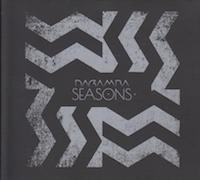Pēc Sanfrancisko latviešu skolas pārzines Māras Lindes ierosinājuma Latvijas simtgades popularizēšanai Amerikas Savienotajās valstīs izveidota ceļojoša Amerikas latviešu apvienības muzeja krājumu latviešu rakstaino cimdu izstāde, kas līdz gada beigām skatāma Ņujorkā.
Ar Ingas Saivares gādību no 8. decembra līdz gada beigām rakstainie cimdi izstādīti lielākajā Ņujorkas pilsētas izšuvumu un adījumu piederumu veikalā Annie&Co Needlepoint&Knitting. Cimdi labi redzami izvietoti veikala skatlogā un piekārti pie veikala griestiem, tā veidojot savdabīgus latviskus rotājumus, radot gada nogales svētku noskaņu gan pašiem darbiniekiem, gan apmeklētājiem un pircējiem, kuru šajā svētku laikā ir sevišķi daudz. Izvietoti informatīvi stendi skaidro dažādo rakstu nozīmi, kā arī cimdu adīšanas tradīcijas Latvijā. Par skaistajiem cimdu rakstiem un jauko ideju tiek saņemts daudz komplimentu. Adītājas interesējas gan par cimdu izcelsmi, to adīšanas tradīcijām, gan par iespējām apgūt kādus no sarežģītajiem rakstiem.
Veikala adīšanas konsultante Inga Saivare interesentiem nenogurstoši stāsta par Latviju, tās vēsturi, rokdarbu un adīšanas tradīcijām, kā arī popularizē latviešu etnogrāfiskos rakstus, kas atrodami grāmatās par latviešu cimdiem. Skaistie cimdi sagādājuši skaistu dāvanu Latvijai nākamā gada valsts simtgadē – daudzi pasaules metropoles Ņujorkas iedzīvotāji un tūristi uzzina vairāk par mūsu valsti un vienu no tās dārgumiem – unikālajiem latvisko cimdu rakstiem. Latvijas vēstnieks ANO Jānis Mažeiks un viņa dzīvesbiedre Dace, apmeklējot izstādi, sirsnīgi pateicās Ingai Saivarei par uzņēmību un Latvijas skaisto tradīciju popularizēšanu Ņujorkā.
Adītāju aprindās latviešu rakstainie cimdi ir labi pazīstami; šāda tipa cimdu aprakstam tiek lietots pat jēdziens “Latvian mittens” jeb “latviešu cimdi”. Savukārt cimdu apmalē bieži izmantotā rotājuma tehnika “pīnīte” angliski pazīstama kā “Latvian Braid”.
Izstāde Ņujorkā skatāma no 8. līdz 31. decembrim veikalā Annie&Co Needlepoint&Knitting, 1763 Second Ave. SW Corner of 92nd St. New York, NY 10128




